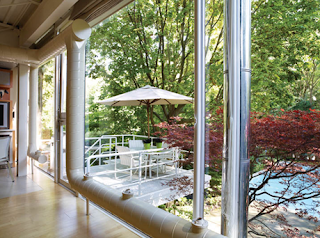Modern architecture deals with the simplicity of the
form. It reduces the building into geometric forms that reveal the true
structure. This style of architecture began in the late 19th century and early
20th century where the industrial revolution had taken place. At this
time, many different resources were available to architects because many industries were growing. Materials such as steel, iron, and glass were often used in this
period and pushed the architects to communicate through materials.
| Crystal Palace- A prime example of early usage of glass and steel construction |
 |
| Manufacturing of steel during the industrial revolution |
In modern architecture, it was believed that materials of a building should not be hidden. Instead, it should be glorified and portray the essence of the building. “Truth to materials” was a phrase that used around the turn of the 20th century to help convey this idea. Another principle that belonged to modern architecture was the lack of ornamentation. Function was key when it came to designing modern buildings and it was believed that decorations did not help with the design of the building-- let alone the idea of simplicity.
 |
| "Form follows function"-- Mies Van der Rohe |
Glass, specifically, was heavily relied upon
during this movement. Not only due to the rapidly growing technology, but also
because it encouraged the idea of exposure of the structure. It was
common for modern buildings to have large expanses of glass. This was used to create a relationship between the inside and outside space.
Architects, especially Mies Van der Rohe believed in this concept and it is evident throughout his projects. Having a steel structure along with glass
panels that reveal all, Mies’ Farnsworth House is a prime example of modern
architecture. The essence of the building is captured and nothing is
concealed.
 |
| The openness of the Farnsworth House |
Along with Mies, Le Corbusier and
Frank Lloyd Wright helped pushed this influential movement. Breaking
from the traditional Victorian style, this new way of designing was
revolutionary. In places such as North America, the spread of modernism was
evident especially in commercial buildings. Steel and glass skyscrapers started
to fill skylines of major cities such as Chicago and New York. In Europe, institutions such as Bauhaus significantly drove modernism
in Europe. Today, architecture is in a place where it is still impacted by
modernism. In fact, it has involved into postmodernism in the 1970s.
---
Modern influences on the Wolf House:
By analyzing Myer’s Wolf House, is it evident that it
was created with a strong modern influence. From the assembly of geometric
forms to the materials used, the Wolf House is a good example of a modern
infill house. The main materials used in the construction were steel, glass, and aluminum sheets. These materials are assembled in a method to reveal and expose the
steel structure of the house, without ornamentation. By this, Myers has
expressed the machine feel of the house. Furthermore, he exposed the ductwork to further convey the industrial style.
 |
| The glass helps create the connection between the inside and the outside space, also revealing the exposed ductwork |
 |
| The steel columns not only elevate the house but also emphasizes the importance of vertical and horizontal lines |
There is also an obvious emphasis of horizontal and
vertical lines through the use of steel studs that run up and down the facades,
the columns that elevate the house and the aluminum panels. The use of glass and the courtyard really helps show the relationship between the
interior space and the beautiful ravine environment. Therefore, this house also reflects
the modernism goal of breaking out of the traditional style of housing.


No comments:
Post a Comment